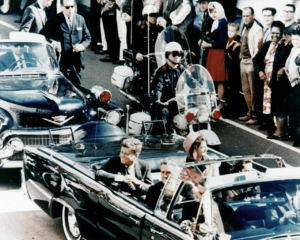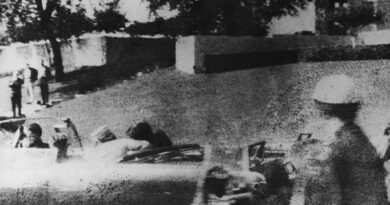The Mainstream Media Was Scared to Investigate the JFK Assassination
It’s not difficult to understand why the mainstream media failed and refused to investigate the JFK assassination. To understand the reason, just think about how Columbia University and the big law firms Paul, Weiss and Skadden Arps have capitulated after being subjected to pressure from President Trump. Why wouldn’t the mainstream media behave in the same manner after being subjected to pressure from President Lyndon Johnson and the U.S. national-security establishment?
Lyndon Johnson was one of the most vicious and ruthless politicians in U.S. history. Every mainstream media outlet knew that. He was also one of the most crooked and corrupt politicians. The mainstream media knew that as well.
Everyone also knew that while he was vice president, Johnson could not bend people to his will by threatening to use the massive power of the federal government to do bad things to them. Everyone also knew that when Johnson became president, that principle no longer held. Everyone now knew that as president, Johnson wielded the power to destroy them or even have them killed by either the military, the CIA, or some other part of the deep state.
If John Kennedy had not been assassinated, it is a virtual certainty that Johnson would have been criminally indicted and convicted for official corruption. He very likely would have been sentenced to serve time in a U.S. prison. He never would have become president. The assassination saved him from that fate.
Prior to the assassination, there were two newspapers in Texas who were investigating aspects of Johnson’s corruption. Immediately after Johnson was elevated to the presidency, he made telephone calls to the heads of those newspapers and pressured them into shutting down their investigations. Both of them capitulated and shut down their investigations.
 LIFE magazine planned to run a story on Johnson’s corruption in its Friday, November 29, 1963, issue. Once the assassination took place on November 22, LIFE cancelled the story and replaced it with assassination coverage. That makes sense. What also makes sense is that LIFE never published the corruption article. That’s undoubtedly because Johnson was now president.
LIFE magazine planned to run a story on Johnson’s corruption in its Friday, November 29, 1963, issue. Once the assassination took place on November 22, LIFE cancelled the story and replaced it with assassination coverage. That makes sense. What also makes sense is that LIFE never published the corruption article. That’s undoubtedly because Johnson was now president.
Did Johnson telephone major U.S. newspapers and order them not to investigate the JFK assassination? He didn’t need to. He simply needed to send them a message stating that they were never to go down that road. That message came in the form of the Warren Commission report on the assassination. Once Johnson heartily endorsed the official lone-nut narrative set forth by the former head of the CIA, Allen Dulles, and other mainstream officials who were serving on the Warren Commission, every newspaper in the land got the message: If you know what’s good for you, accept the official lone-nut narrative, no matter how ridiculous it might seem, and let’s just move on.
What is fascinating is how the mainstream media adhered to its non-investigative policy long after Johnson was gone. That may well be because of their fear of the deep state, which many people were gradually realizing had orchestrated and carried out the assassination.
Let’s review four examples of how the mainstream media failed and refused to investigate the JFK assassination, even decades later.
1. In the 1990s, the Assassination Records Review Board reported that there had been two brain examinations as part of the Kennedy autopsy. The military pathologists had lied. They had claimed there was only one brain examination. The ARRB was able to discover the truth in two ways. First, the official autopsy photographer, John Stringer, stated that he had taken the photographs of the brain at the brain exam he attended. When he was asked to examine the brain photographs in the official record, he said that those were not the photographs he took. Second, one of the three military pathologists, Col. Pierre Finck, was not at the brain exam that Stringer attended. He was at the second one, where there was another photographer whose identity was kept secret. For reasons laid out in the ARRB report, the second brain exam almost certainly involved a brain that did not belong to Kennedy — i.e., a brain specimen that most likely came from the nearby medical school at Bethesda National Naval Medical Center.
The ARRB’s report on the two brain exams hit the mainstream media soon after it was published in the 1990s. Wouldn’t you think that some newspaper would want to get to the bottom of this? After all, there is perjury by military doctors and fraud in the autopsy. Aren’t those things worth investigating? One would think so. But as far as I know, not one mainstream media outlet assigned an investigative journalist to check it out. It would have been considered too dangerous. It would have been investigating the military and the role it played in the Kennedy assassination.
There is something else to consider here. The mainstream media had to know that the ARRB was prohibited from investigating the matter as well as anything other matter relating to the JFK assassination. That’s because someone in Congress had slipped into the JFK Records Act a provision prohibiting the ARRB was investigating any aspect of the JFK assassination. Knowing this, wouldn’t you think at least one mainstream media outlet would investigate the matter? Nope.
2. After the House Select Committee in the 1970s released Navy personnel who had participated in the autopsy from the vows of secrecy they had been forced to take, enlisted men began reporting that they had secretly carried JFK’s body into the Bethesda military morgue in a shipping casket rather than the heavy ornate casket into which the body had been placed in Dallas.
Wouldn’t you think that some major mainstream newspaper would find that something worth investigating? Nope.
In the 1990s, the ARRB also discovered the existence of a former Marine Sgt. named Roger Boyajian, who had been in charge of security at the Bethesda morgue, where the military autopsy of JFK’s body was to be conducted. Boyajian produced a copy of an after-action report he delivered to his superiors soon after the autopsy. The report stated that the shipping casket had been brought into the morgue at 6:35 p.m. That was almost 1 1/2 hours before the 8:00 p.m. time when the body was officially brought into the morgue for the autopsy.
What was the purpose of sneaking JFK’s body into the morgue almost an hour and a half before the official entry time of the body into the morgue? Wouldn’t you think that that would be enough for some major newspaper to investigate? Nope.
3. After the assassination and autopsy, the social photographer for Kennedy and several other presidents, Robert Knudsen, stated publicly that he had been the photographer for the autopsy. He said that it was the hardest thing he had ever done. When he passed away, both the New York Times and the Washington Post published obituaries stating Knudsen had been the photographer for the JFK autopsy.
There was one big problem. Knudsen wasn’t the official photographer for the autopsy. That was John Stringer. It was undisputed that Knudsen wasn’t at the autopsy. But based on his good reputation as the official White House photographer both before and after Kennedy, it is a virtual certainly that Knudsen wasn’t lying. He obviously photographed something he was led to believe was the autopsy.
Wouldn’t you think that some mainstream newspaper would want to get to the bottom of the Knudsen mystery? Nope.
4. The ARRB discovered the existence of a woman named Saundra Spencer. On the weekend of the assassination, she was a Navy petty officer who worked in the Navy photography lab in Washington, D.C. She worked closely with the Kennedy White House. She told the ARRB that she had been asked to develop the autopsy photographs on the weekend of the assassination, on a top-secret basis. When the ARRB showed her the autopsy photographs in the official record, she stated that the photograph depicting the back of Kennedy’s head to be intact was not correct. She stated that the photograph she developed showed a 1-2 inch hole in the back of JFK’s head. Since the photograph she had viewed was done after the embalmers had done their best to patch up the back of JFK’s head, it is a virtual certainty that that hole was much actually much larger, which matched what the Dallas physicians had stated — that there was a massive exit-sized hole in the back of Kennedy’s head, which would imply a shot having been fired from the front, which contradicted the official lone-nut-firing-from-the-rear narrative.
Wouldn’t you think some mainstream newspaper would want to get to the bottom of this? Nope.
Why is all this important? Because there is no innocent explanation for a fraudulent autopsy. Once evidence of fraud in the Kennedy autopsy surfaced, it was “case closed” on criminal culpability on the part of the U.S. national security establishment. Wouldn’t you think that would be something the mainstream media would want to investigate? Nope.
For more on the fraudulent autopsy conducted by the military, see my books The Kennedy Autopsy and The Kennedy Autopsy 2.


